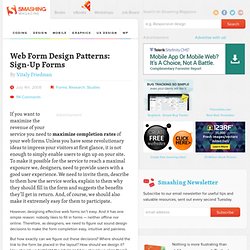

Web Form Design Patterns: Sign-Up Forms, Part 2 - Smashing Magazine. Advertisement Last week we have presented first findings of our web forms survey1.

The main objective of the survey was to provide designers and developers with some intuition of how effective web forms are designed; we also presented some guidelines of how an effective and user-friendly web form can be achieved. We have focused on sign-up forms as we wanted to consider further crucial forms (e.g. checkout forms) separately. Afterwards we’ve gone through each and every one sign-up form of the selected sites and analyzed the design approaches implemented in these forms. Below we present the second part of our findings — the results of our survey among web-forms of 100 popular web-sites where web-forms (should) matter.
Please notice that this post is not about checkout forms — that’s a topic for another discussion, we may consider them separately in one of the upcoming posts. 3. 3.1. 3.2. 3.3. If hints and help appear, they appear… 3.4. According to our research, Web Form Design Patterns: Sign-Up Forms - Smashing Magazine.
Advertisement If you want to maximize the revenue of your service you need to maximize completion rates of your web forms.

Unless you have some revolutionary ideas to impress your visitors at first glance, it is not enough to simply enable users to sign up on your site. To make it possible for the service to reach a maximal exposure we, designers, need to provide users with a good user experience. We need to invite them, describe to them how the service works, explain to them why they should fill in the form and suggests the benefits they’ll get in return.
And, of course, we should also make it extremely easy for them to participate. However, designing effective web forms isn’t easy. But how exactly can we figure out these decisions? Below we present findings of our survey of current web form design patterns — the results of an analysis of 100 popular web-sites where web-forms (should) matter. Sign-Up Form Design Survey We have selected 100 large sites where web-forms (should) matter2. Components Versus Patterns. By Nathan Curtis, EightShapes Originally published: Jan 09, 2009 Invariably at the outset of planning a component library, stakeholders will query “Ah, yes, so we are building a pattern library?”

Actually, no. Although the two concepts are strongly related, their differences warrant consideration to ensure you are building the type of library that’s right for you. What Is a Pattern? A pattern is a global solution to a common design problem, such that you could use the solution many times and never quite use it the same way twice. For example, there’s no reason for a designer to not employ the common tenants of tabs (such as at least two tabs are required), video playback (that can be played or paused), or authentication (that, at a minimum, requires some form of username and password).
What Is a Component? On the other hand, components are a reusable, design system-specific chunk of a page. How Are Components and Patterns Related? Are the components and patterns the same? User Interface - Stack Exchange.